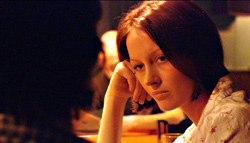Made in the southern Ohio–West Virginia area using local residents (none of them trained actors), Steven Soderbergh’s Bubble is such a high-tech, no-frills affair that its studied naturalism begins to blur with the environment, like Dreiser on DV. But the plot’s as familiar as an episode of America’s Most Wanted: A triangle forms between three workers in a doll factory, one male and two female, which leads to a murder and police investigation.
Bubble‘s unusual production and distribution are more interesting than anything in the film, which is being released simultaneously in theaters and on DVD and cable through companies controlled by Internet billionaire Mark Cuban. (Cuban owns Landmark Theatres, parent to the Metro, which will project the film digitally.) This eliminates the troublesome and fast-declining traditional “window” between theaters and small screens (i.e., home video, cable, on-demand, broadcast, etc.), since the latter revenues are actually much larger than box-office proceeds these days. Which may lessen marketing and distribution costs, and increase the old “ancillary” revenue stream while Bubble is still fresh in the public’s mind. You can watch it via whichever medium you prefer—which drives theater owners crazy, of course.
None of which speaks to product quality. I mention the above only because Cuban’s digital experiment made it possible for Soderbergh, ever the innovator, to shoot this noncommercial movie exactly as he saw fit—artistic risk without commercial risk. (He’s signed on to produce five more titles in this manner.) The problem with Bubble isn’t the three nonpro leads; it’s that the script feels like it was written by rookies, too. (Full Frontal screenwriter Coleman Hough did the honors.) Everything about it seems numb, predictable, and routinized, like the factory work itself. An audacious script filmed in this manner would be different, or even some bare-bones condensation of a classic. (Hamlet on the factory floor, perhaps?) Here, one’s main impression is that it sure does suck to make dolls for a living.
Soderbergh never patronizes his cast members or makes them look like amateurs, and it’s possible that we actually pay closer attention to their words because they don’t enunciate and emote with professional precision. Their faces are perfectly unremarkable and expressive, and Bubble works best when they silently go about their factory routine: extruding plastic doll heads from molds; rummaging through bins of tiny pink limbs; airbrushing red infant lips and applying uncanny glass eyes. It’s as if Soderbergh really wants to make a Frederick Wiseman–style documentary, minimally scored by the thrumming of Guided by Voices’ Robert Pollard.
I can’t tell you to wait for the DVD, because Bubble will already be on DVD. I don’t think Soderbergh means this as an ironic slap to the audience (though after Full Frontal, one can’t be sure). One thing’s for certain: If filmmakers want to reverse the steady decline in theater attendance, they need to think more about what’s inside the box, and less about how it’s delivered. (R)








